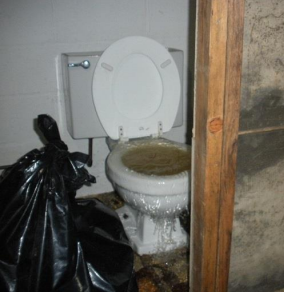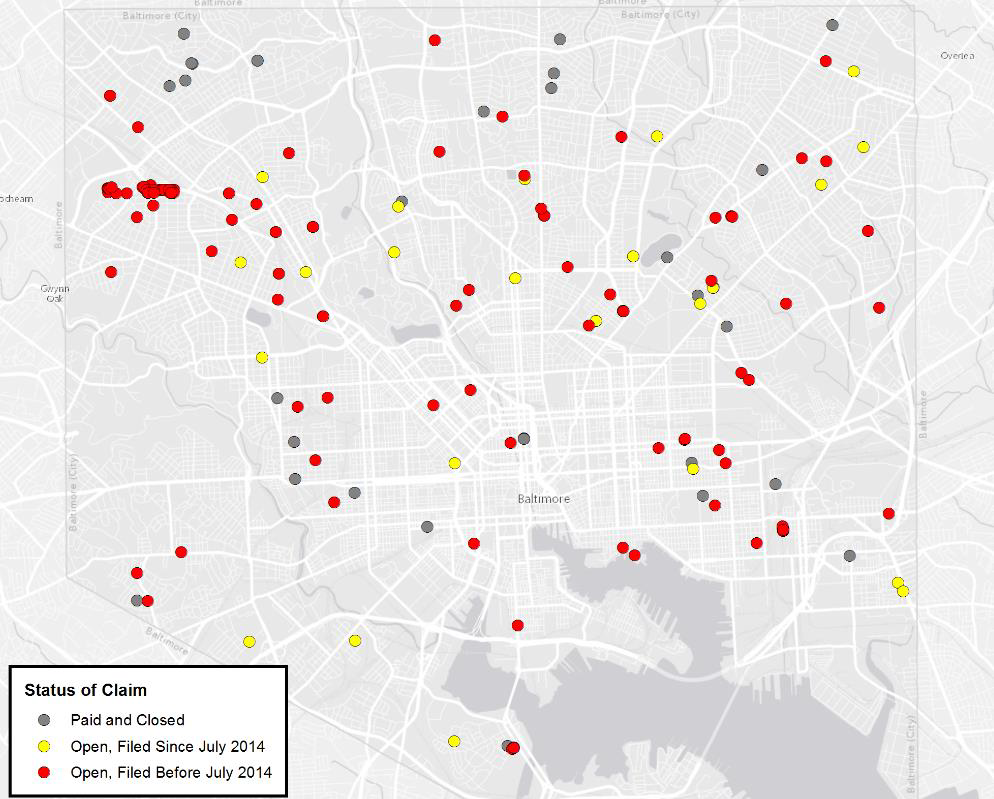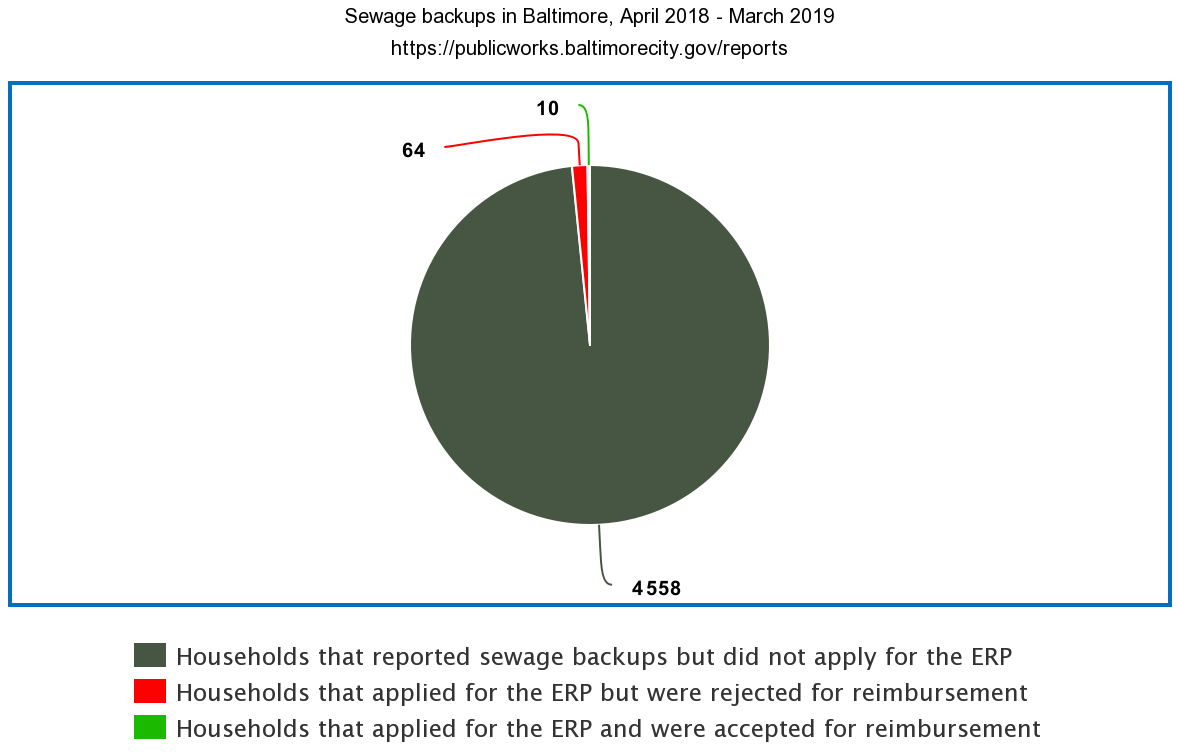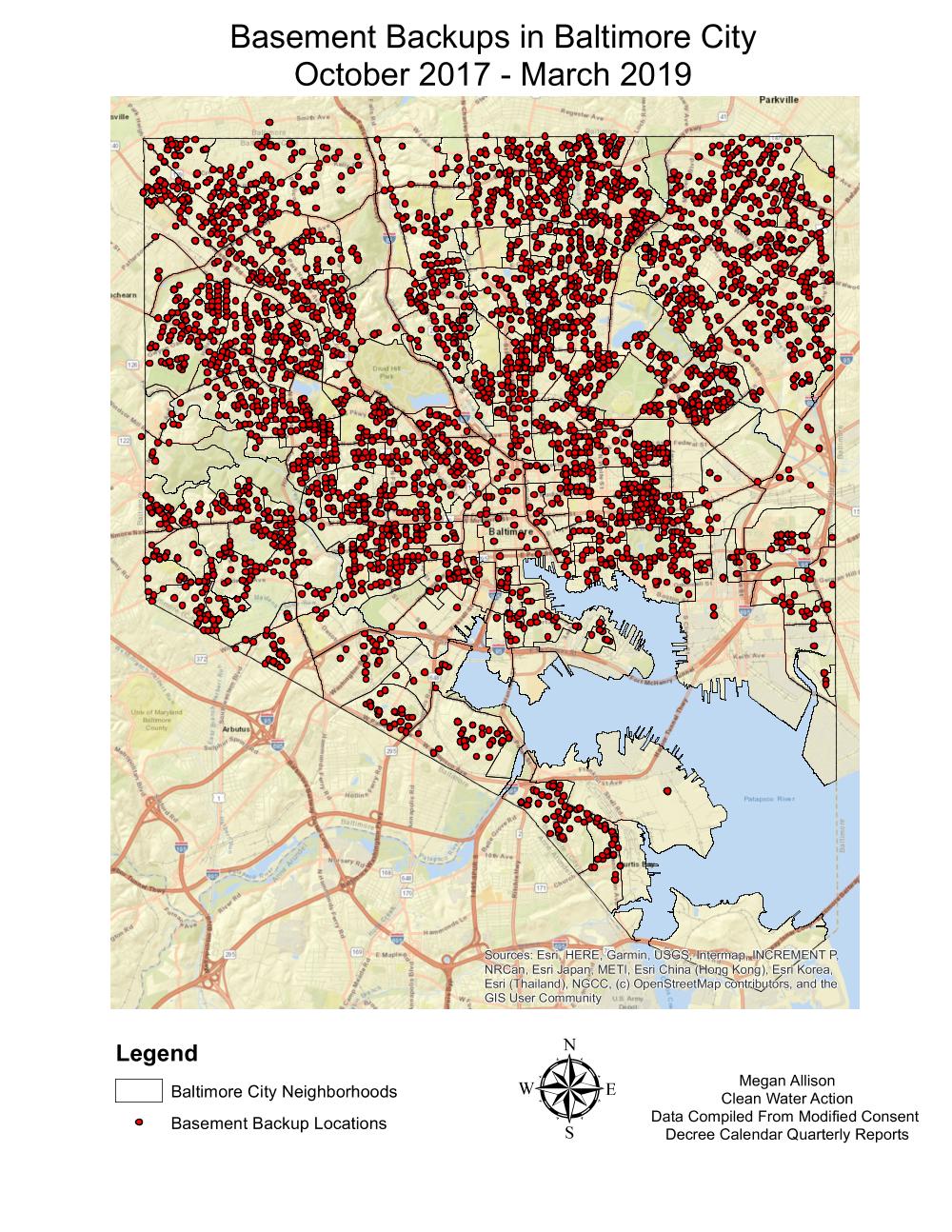
Heavy rainfall stresses all of our infrastructure: flooded transportation systems, leaking houses developing mold, inundated drinking water sources full of polluted runoff, and sewage systems letting rainwater leak in and sewage flow out. In Baltimore City, aged sewage infrastructure doesn't only cause millions of gallons of sewage to flood urban streams, or sinkholes to swallow city streets. It also causes toxic sewage to back up into residents' homes, putting their health and financial security in danger. With more than 5,000 building backups of raw sewage reported every year, but no direct emergency response and underutilized programs to assist with the cost, Baltimore City needs to do more to help residents with this persistent public health threat and financial burden.
Baltimore City's sewage system was designed with dozens of Sanitary Sewer Overflow Structures: intentional release valves that allowed sewage to overflow into streams, rather than streets or people's basements. Although this was a best practice in the early 1900s, using streams as open sewer pipes is a significant public health and environmental threat and in violation of the Clean Water Act In 2002, Baltimore City finalized a Consent Decree, a legally-binding agreement with EPA and MDE outlining how it would end the chronic sewage overflows into local streams that were fouling the Inner Harbor, contributing to overloads of key pollutants, and putting people in danger of contacting hazardous fecal bacteria by 2016.
Between 2002 and 2016, Baltimore City completed less than half the work that was described in the Consent Decree - but backups of sewage into homes in Baltimore grew from a minor problem to a major hazard. According to an investigation by the Baltimore Sun, DPW crews responded to 622 sewage backups in their homes in 2004; by 2015, there were nearly 5,000. And although sewage backups can be caused by a variety of problems - from tree roots growing into a lateral sewer line, to individuals flushing inappropriate materials down the drain - many are caused by capacity issues, maintenance issues, or stormwater flooding into the sewer line through cracks and overwhelming it. (Read an analysis by CityLab here.) Closing sites where sewage overflowed into local streams even contributed to backups elsewhere: as DPW's General Counsel stated to WYPR in 2015, "when we closed those other 60 overflows that actually increased the number of basement backups that we saw in the city. Again, because the sewage has to go somewhere."
Many city residents filed legal claims with the city to recoup their damages - which sometimes topped tens of thousands of dollars. (Click here for application forms for the city's claims process.) But without a deadline for response by the city, many of those applications sat in limbo for years. And when residents filed legal claims with Baltimore City to recoup their costs - sometimes tens of thousands of dollars - their applications frequently sat unresolved for years or were denied.
READ MORE: Stopping the Flood Beneath Baltimore's Streets: The city's failure to comply with a federal consent decree, and how delay harms homeowners and the Inner Harbor (Environmental Integrity Project, December 2015). This report, compiled at the close of the first Consent Decree, outlines the decades of delay that caused the city to complete only half of the repairs required by the deadline of January 1, 2016, and how the repairs that were completed contributed to the massive increase in sewage backups over the same period.
From July 1, 2012 to July 1, 2015, Baltimore’s Law Department received 413 claims from homeowners about damage to their properties from sewage overflows. The claims represented only a portion of the overflow incidents experienced by city residents, however. This is because many people simply notify Baltimore through the city’s 311 complaint hotline and are not provided information on how to submit claims, or they are discouraged from submitting claims because the city has either denied or failed to respond to past claims submitted by residents. Of the 413 claims that were submitted by city residents over the last three years, only 38 claims have been paid by the city (9%). Meanwhile, Baltimore has denied 223 of the claims submitted (54%) while 152 claims remain open and unpaid (37%). In addition, 122 of these open claims are more than one year old.

As the first Consent Decree period came to a close, residents who had experienced sewer backups spoke out and organized to make change - and won.
The Modified Consent Decree requires Baltimore City to complete an initial phase of urgent repairs by 2021, and eliminate remaining sources of sewage overflows by 2030. EPA and MDE for the first time also required the City to address the problem of building backups (defined as when wastewater or sewage is released or backs up into a building Caused by blockages, flow conditions, or malfunctions in the city's sewage collection system, but not if the blockage, flow conditions, or malfunctions are caused by private lateral or other piping systems not owned or controlled by the city). This agreement outlined several requirements for the city to address basement backups:
- Recurring building backups: The city will create a report listing certain block or areas that have reported more than one building backup due to rainwater event and identify a solution. (pg. 21)
- Operations and Management Plan: Within this larger plan for maintaining the sewage system, Baltimore was required to create a program for finding, prioritizing, and repairing broken or leaking lateral sewage lines (the pipes carrying sewage from homes to the sewer main lines under the streets) that cause building back-ups. According to an analysis by the Environmental Integrity Project, the city's plan may fail to find laterals that contribute to back-ups in low-income neighborhoods. 48% of claims for damage from basement back-ups submitted to the City Law Department from July 2015 through February 2017 were for buildings in census tracts with an average household income of less than $42,000. However, only 27% of laterals causing back-ups identified through City's program are in those neighborhoods. Read more and download the Plan and our comments here.
- Emergency Response Plan: This plan for responding to all sewage spills incorporates plans for building backups. It states that when 311 receives a report of sewage backups, they will forward it to the Cityworks Computerized Maintenance Management System, and DPW will quickly respond to identify and eliminate the source of the backup. It outlines that DPW will use its website, brochures, news releases, press conferences, public events, social media, flyers, presentations, and water bill inserts to publicize information about building backups, including the new Expedited Reimbursement Program. Read more and download the Plan and our comments here.
Quarterly Reports
The Modified Consent Decree requires DPW to report its progress every three months on eliminating the 15 remaining Sanitary Sewer Overflow Structures and conducting related repair, maintenance, and programmatic work outlined in the agreement. Each report can be downloaded here.
| Oct-Dec 2017 | Jan-Mar 2018 | Apr-Jun 2018 | Jul-Sep 2018 | Oct-Dec 2018 | Jan-Mar 2019 | |
|---|---|---|---|---|---|---|
| Number of backups | 1,269 | 1,521 | 1,411 | 1,166 | 1,070 | 985 |
| Number caused by wet weather | 114 | 342 | 355 | 428 | 322 | 261 |
| Percent caused by wet weather | 9% | 23% | 25% | 37% | 30% | 27% |
| Number of general claims filed | 18 | 20 | 68 | 39 | 46 | 58 |
| Claim Status: Open | 18 | 15 | 36 | 22 | 42 | 28 |
| Claim Status: Closed | 0 | 5 | 32 | 17 | 4 | 30 |
Because these figures are generated from 311 calls for service, we know that these figures do not reflect the total number of sewer backups experienced by Baltimore City households. Consistently, DPW is determining that less than a third of sewer backups are caused by wet weather - making most households ineligible for the Expedited Reimbursement Program.
- Quarter #1 (October-December 2017), two SSOs were eliminated. The report announced that the Expedited Reimbursement program would begin in April 2018 and would be advertised through media on the DPW website, at community outreach events, in billing inserts, and given as guides distributed when the city responds to a sewage backup event to their customers.
- In Quarter #2 (January-March 2018), one SSO was eliminated. During this quarter, DPW was developing an electric system to process applications for the Expedited Reimbursement Program. Notices to process for construction were given to both Sewer rehabilitation in Herring Run Sewershed/Chinquapin Run and sewer rehabilitation in High Level Sewershed.
- In Quarter #3 (April-June 2018), no SSOs were eliminated. Notices to process for construction were given to both system improvements in areas of Jones Falls Sewershed and sewer improvements in South West area of Baltimore. The Expedited Reimbursement Program began in April 2018, and the report stated that "several" applications had been processed.
- In Quarter #4 (July-September 2018), no SSOs were eliminated. A notice to process for construction was given for sewer collection system improvements in the North West area of Baltimore. The report noted again that "several" applications to the Expedited Reimbursement Program had been processed.
- In Quarter #5 (October-December 2018), no SSOs were eliminated, but the report shared that the City has approval for designs required to eliminate one, and had proposed plans to eliminate two more. A notice to process for construction was given for sewer collection system improvements in the North West area of Baltimore. The report noted that DPW was continuing to process applications to the Expedited Reimbursement Program, but did not provide any further information. At a public meeting in January, however, DPW employees shared with the press that 67 applications had been processed, and only 10 households had been reimbursed. 82% of the applications processed had been rejected - about a quarter of them rejected because the household did not call 311 within 24 hours of the backup occurring, and another quarter because DPW determined that the backup was not caused by rain.
- In Quarter #6 (January-March 2018), no SSOs were eliminated, but the report noted that the City was working on plans to eliminate two. A notice to process for construction was given to the Back River Wastewater Treatment Plant Headworks Project. The report noted that the City had processed "over 70 applications since it began."
- Quarterly Report #7 (April-June 2018) did not include information about the total number of sewage backups during that period, likely due to the ransomware attack that stalled city administration during that time period. However, it did include a report on the administration of the first year of the Expedited Reimbursement Program that showed that only 74 households applied to the program, and only 10 of them had their applications accepted. 26 were denied simply on the basis that the city hadn’t been notified within 24 hours or application submitted within 90 days. Other denials were because the event wasn’t considered to be caused by wet weather, household wasn't in Baltimore city, or the event occurred before the expedited reimbursement program began. The city hasn’t eliminated any more SSO’s but plans to eliminate SSO #137 within the next calendar quarter. The city is being impeded by some difficulties concerning improvement and repair projects. The 7th quarterly report read: “the City has experienced the following adverse impacts associated with contracting capacity: x Unbalanced project bids; x Fewer prospective bidders; x Insufficient numbers of crews assigned to projects; x Untrained or inexperienced crews assigned to projects; and x Increased need for re-work due to poor quality installation. These issues potentially create significant project completion delays and much higher costs associated with both initial project bidding and on-going project re-work. The City continues to utilize best practices to mitigate the aforementioned challenges and is currently on track to meet the January 1, 2021 deadline for completion of Phase 1 projects.” None of the city’s phase 1 projects have been completed during the 7th quarter, and no phase 2 projects have been started. 78 SSO collection events occurred in this quarter, 38 wet, 40 dry events with a total of 7,574,732 gallons. 4 SSO structure overflow events occurred with a total of 13,495,000 gallons of water. 9 sanitary discharges of unknown origin occurred during the quarter. 5 have been resolved, 4 are currently unresolved. 3 still affect the Jones Falls, 1 affects the Gwynn Falls. The most severe ongoing discharge is at 3316 Bancroft Rd which has discharged 467,743 gallons to date affecting the Jones Falls.

READ MORE: Residential Sewage Backups in Baltimore City, Fiscal Year 2018 (Faith C. Ezell, Master of Health Science Candidate, Johns Hopkins Bloomberg School of Public Health). This master's thesis, written in collaboration with Clean Water Action and the Environmental Integrity Project, outlines the history of Baltimore's sewage system, negative health impacts of exposure to sewage, and the increasing risk of extreme rainstorms due to climate change. By analyzing and mapping data released in the first four Modified Consent Decree Quarterly Reports, covering October 2017 - September 2018, the report demonstrates that operations and maintenance work reported by DPW does not necessarily align with where basement backups are happening most frequently, that most basement backup occurances are not eligible for reimbursement under the Expedited Reimbursement Program as it is currently set up, and that sewage backups are more likely to occur in neighborhoods with a higher proportion of African American residents in Baltimore City.

What you can do if a basement sewage back-up happens to you:
- Use 311 to report the problem right away. The City uses 311 reports to track where back ups are happening and prioritize repairs, and you must call 311 within 24 hours of the back up to be eligible for the Expedited Reimbursement Program.
- If possible, do not clean it yourself. Exposure to raw sewage is a significant health risk. Please contact professionals to clean it for you. If handling items contaminated with sewage is unavoidable, always wear gloves.
- Keep receipts for all cleaning costs and property damage. Providing records of the event is required under the Expedited Reimbursement Program and can be used to support a General Liability Claim.
- Apply for the Expedited Reimbursement Program - download the forms here. Baltimore City may reimburse you for up to $2,500 for cleaning costs, but there are some restrictions. Among other things, you must call 311 within 24 hours of the back up and submit your reimbursement application within 90 days. For more information, visit: https://publicworks.baltimorecity.gov/sewer-consent-decree/building-back...
- Consider filing a General Liability Claim for additional cleanup costs and property damage - download the forms here.
- Contact us to share your story. We want to know what happened, how much it cost to clean and replace damaged items, whether you apply for city programs, and what happens when you do.